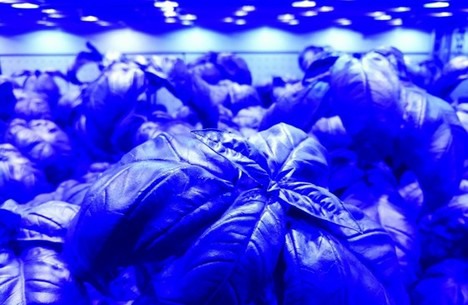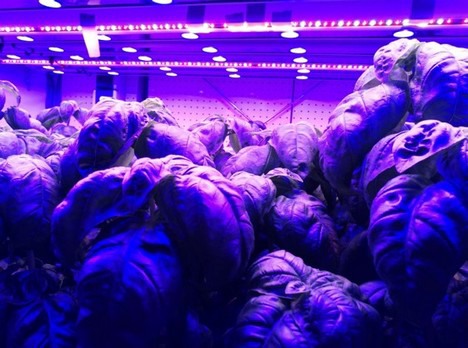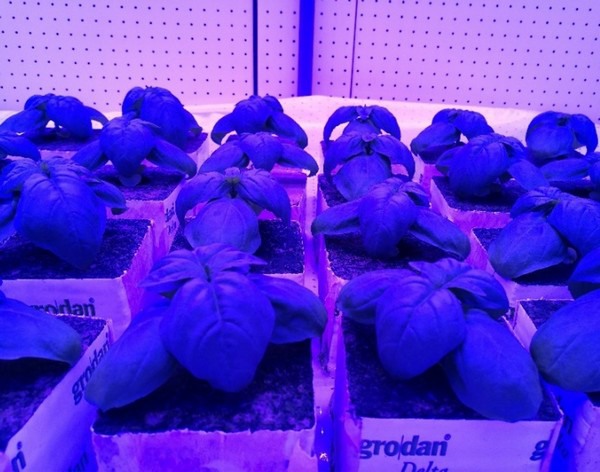Basil has been cultivated for centuries and is one of the most popular culinary herbs in the world. The fresh flavor it offers cannot be matched by any other herb or spice, making this delicate plant an excellent choice to grow indoors. Unfortunately, basil leaves will turn black when they are damaged, which can easily happen when basil is exposed to low temperatures during transport or storage. Due to the delicate nature of the crop, basil is not only one of the most expensive herbs for the consumer but also one of the most perishable. If blue LED lighting can help strengthen the crop's metabolic profile, it would increase its value to the retailer, end-consumer, and grower as well.
Studies have shown that the use of blue light in vertical farming can have a strong influence on a variety of crops, increasing their flavor profile and overall quality. But when it comes to the application of blue light, there is no one size fits all approach. Together with Wageningen University, we wanted to see if basil would have a positive reaction to an increased level of blue light, as showcased by previous research conducted on lettuce. But we were surprised to find that basil's performance under increased blue LED lighting did not resemble the previously researched performance of leafy greens and fruits.

A delicate nature
"Researching the effects of blue lighting on a crop like basil allows us to ensure we are achieving the best taste and quality possible," explains Dr. Céline Nicole, plant specialist at Philips horticulture LED solutions. Nicole explains that basil, like other aromatic herbs, contains many phenolic compounds that are used by the plant for its protection, growth, and reproduction.
Phenolic compounds are a group of plant substances that are naturally found in fruits, vegetables, and leafy greens and provide health benefits to both the consumer and the plant. For example, a plant's phenolic profile can help protect a plant from blackened leaves due to oxidative damage, as well as deliver antioxidant and anti-inflammatory nutritional values to the consumer. Blue light is known to stimulate these compounds more than any other LED wavelength. Additionally, they also affect the taste and other organoleptic properties, making the right LED recipe essential to achieving the best crop harvest quality.

Comparing two treatments
During the study, we wanted to see if the addition of a higher amount of blue light made a difference in the shelf life and quality of the basil. The test was divided into two groups, using different light treatments for both green and purple basil.
For both groups, the seedlings were grown in a controlled climate chamber under Philips GreenPower red/white light, and the lights were kept at 25cm above the plants. The day and night temperatures were set at 25°C, relative humidity set at 75%, and the crop was watered through an ebb and flow system. The basil was kept at comfortable CO2 levels. Several cultivars were tested in these experiments.

Experiment 1 investigated different percentages of blue light applied either as a continuous treatment throughout the growth (i.e., for 25 days) or as EOP (End of Production).
Experiment 2 investigated different EOPs with various percentages of blue light up to 90%. All plants were harvested 35 days after sowing.
Unexpected results
Surprisingly, the findings of this study show that basil does not appear to be positively affected by blue LED lighting in a similar way as previously researched results for leafy greens and fruits. Other than purple basil showing a higher starch and sugar content at postharvest — possibly allowing it to withstand chilling bruises at 4°C — there was little change over time for both groups at 12°C storage.
Most importantly, the crop's phenolic profile did not change much. Rosmarinic acid, a key phenolic compound that contributes to basil's antioxidant and anti-inflammatory properties, was not affected. Additionally, there was no significant increase in the levels of anthocyanins, which affect the plant's color, or on metabolites, which affect a plant's taste profile.
The right recipe
"This research confirmed that the light recipe we applied in our Philips GreenPower LED grow lights for basil production actually guarantees the highest possible taste and crop quality we can achieve with LED lighting so far. We are confident to provide the best light recipe for our customers to grow basil in a vertical farm; that will not only guarantee the yield, but that will also ensure an optimal quality of the crop." asserts Nicole. This research shows that the addition of extra blue light is not a one-size-fits-all solution, and it is important to provide growers with optimal advice for their situation based on thorough research.
 For more information:
For more information:
Signify
Daniele Damoiseaux, Global Marcom Manager Horticulture
[email protected]
www.philips.com/horti
